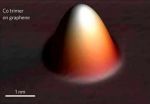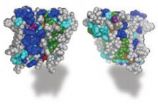(Press-News.org) While fear of terrorist attacks overshadows the Olympic Games, the "lone wolf" terrorist is a cause for concern: one who is almost impossible to track by means of the "usual" intelligence and tracking tools. Prof. Gabriel Weimann of the University of Haifa, who has been monitoring terrorism on the Internet for over a decade, has found that most of these individuals do find a "virtual wolfpack" to belong to on the net.
A mounting global threat is of terrorists who act as "lone wolves". Locating and preventing such terrorist activity is more complicated than organizational terror threats. A new study conducted by Prof. Gabriel Weimann of the University of Haifa, reveals that these "lone wolves" are not in fact so isolated and belong to virtual terrorist communities on the Internet. "We may be able to better prevent 'lone wolf' terrorist attacks by following the radicalization of opinions being expressed online and by tracking the enlistment and training processes that are happening in that sphere," noted Prof. Weimann.
In recent years the number of "lone wolf" terrorists has been on the rise. They act alone, influenced by radical ideologies, and are not members of any organization or subjects of any organizational hierarchy, making it particularly difficult and almost impossible to locate them before they carry out attacks. Making it even more difficult to locate such individuals is the fact that they do not belong to any specific sector of the population and could in fact be "the guy next door". According to Prof. Weimann, intelligence organizations are aware that much of the terrorist activity is shifting from the known terrorist organizations to "lone wolf" activity, and even President of the United States Barack Obama commented in 2011 that this type of attack has become the most likely to cause harm in the Western world.
In his new study, Prof. Weimann shows that these wolves are probably not so 'lonely'. As part of a long-term study that he launched over ten years ago, Prof. Weimann has been surveying encoded and public international terror organization websites, as well as sites supporting these organizations, forums, video clips, and whatever information there is on the net relating to global terrorism. According to Prof. Weimann, most of the "lonely wolves" make contact, share information, and acquire training through the Internet, whether from sites that are linked with terror organizations, from forums supporting such organizations, or from other platforms. In addition to this sort of "regular" activity on the web, social networks provide these individuals with their virtual wolfpack: a virtual community of people who think like them, who share their ideals, and with whom they can consult and share advice. "The virtual community gives the 'lone wolf' social environment, support, and moral encouragement," Prof. Weimann notes.
The researcher presents a number of examples of such terrorists who supposedly acted alone. It was revealed that American officer Nidal Hasan, who shot and killed thirteen American soldiers, had communicated with a known terrorist through the Internet. Arif Uka, a young Bosnian who shot and killed American soldiers in Frankfurt, was a Facebook friend of various known Islamist radicals.
Another known example is the Internet activity that followed Mohamed Merah's attack killing four Jews in Toulouse a number of months ago. Monitoring the web, Prof. Weimann has observed that immediately after Merah was killed in a police siege, members of Jihadist online forums began praising Merah's act and encouraged additional acts like it. A Facebook page praising the killings was promptly created and by the time it was closed down with the involvement of the French government, 500 Facebook users had joined it. According to Prof. Weimann, it is these types of forums and activity that must be monitored to locate and identify the next "lone wolf".
"Enlistment, confidence building, explanations as well as social support for the 'lone wolves' are all becoming available on the Internet. These sites can be monitored. Depending on how deeply the law will get involved in this sort of Internet activity is what will determine the time it takes to sound the alarm on an individualist's intended act of terror. Clearly, undercover agents will be able to penetrate the terrorists' social networks by becoming more familiar with this sort of activity," concludes Prof. Weimann.
.
### For more details contact Rachel Feldman
Tel: +972-54-3933092
Communications and Media Relations
University of Haifa
rfeldman@univ.haifa.ac.il
How the 'lone wolf' terrorist networks
Isolated terrorists are not formally connected to organizations - but do belong to virtual communities in social networks, a new study shows
2012-08-02
ELSE PRESS RELEASES FROM THIS DATE:
A drug-screening platform for ALS
2012-08-02
Kyoto, Japan, Aug. 1, 2012 - A research group at the Center for iPS Cell Research and Application (CiRA) at Japan's Kyoto University has successfully recapitulated amyotrophic lateral sclerosis (ALS)-associated abnormalities in motor neurons differentiated from induced pluripotent stem cells (iPSCs) obtained from patients with familial ALS, a late-onset, fatal disorder which is also known for Lou Gehrig's disease. In a drug screening assay using the disease model, the team further found that the chemical compound anacardic acid can rescue some ALS phenotypes in vitro.
In ...
Debris flows, landslides, fossil microatolls, paleo-seasonality, and carbonate ore deposits
2012-08-02
Boulder, Colo., USA – Two Geology studies focus on debris flows and landslides, one from the point of view of alpine denudation and the other studying and quantifying hazards to human populations. Subjects of other studies include fossil microatolls and sea level; the potential rupture area for an earthquake offshore of the U.S. Pacific Northwest and British Columbia; paleoclimate; and the relationship between the formation of ore deposits and the growth cycle of microbial communities.
Highlights are provided below. GEOLOGY articles published ahead of print can be accessed ...
A direct look at graphene
2012-08-02
Perhaps no other material is generating as much excitement in the electronics world as graphene, sheets of pure carbon just one atom thick through which electrons can race at nearly the speed of light – 100 times faster than they move through silicon. Superthin, superstrong, superflexible and superfast as an electrical conductor, graphene has been touted as a potential wonder material for a host of applications, starting with ultrafast transistors. For the vast potential of graphene to be fully realized, however, scientists must first learn more about what makes graphene ...
Global health researchers urge integrating de-worming into HIV care in Africa
2012-08-02
HIV care centers are an important and highly accessed point of care for HIV-infected children and their families in sub-Saharan Africa, but opportunities to address other health issues are being missed. Proven interventions, including routine deworming among young children, could be effectively integrated into HIV care according to a newly published article in PLoS by University of Washington researchers.
The article, "Integration of Deworming into HIV Care and Treatment: A Neglected Opportunity," estimates that millions of HIV-infected individuals in sub-Saharan Africa ...
UCLA-led project aimed at African American couples affected by HIV gets $2.5 million boost
2012-08-02
A UCLA-led project to implement a unique HIV intervention program aimed at reducing sexually risky behaviors and promoting healthier living among heterosexual African American couples has received a $2.5 million grant from the National Institute of Mental Health.
The program, based on Eban — a Yoruban concept from West Africa that symbolizes "safety, security and love within one's family and community" — is designed not only to reduce the risk of HIV and other sexually transmitted diseases but to increase couples' ability to communicate with each other, make safer behaviors ...
Is it a rock, or is it Jell-O? Defining the architecture of rhomboid enzymes
2012-08-02
Johns Hopkins scientists have decoded for the first time the "stability blueprint" of an enzyme that resides in a cell's membrane, mapping which parts of the enzyme are important for its shape and function. These studies, published in advance online on June 14 in Structure and on July 15 in Nature Chemical Biology, could eventually lead to the development of drugs to treat malaria and other parasitic diseases.
"[It's] the first time we really understand the architectural logic behind the structure of the enzyme," says Sinisa Urban, Ph.D., an associate professor of molecular ...
Mending a broken heart -- with a molecule that turns stem cells into heart cells
2012-08-02
LA JOLLA, Calif., August 2, 2012 – For years, scientists have been looking for a good source of heart cells that can be used to study cardiac function in the lab, or perhaps even to replace diseased or damaged tissue in heart disease patients. To do this, many are looking to stem cells. Researchers at Sanford-Burnham Medical Research Institute (Sanford-Burnham), the Human BioMolecular Research Institute, and ChemRegen, Inc. have been searching for molecules that convert stem cells to heart cells for about eight years—and now they've found one. Writing in the August 3 issue ...
Genetic copy-number variants and cancer risk
2012-08-02
Genetics clearly plays a role in cancer development and progression, but the reason that a certain mutation leads to one cancer and not another is less clear. Furthermore, no links have been found between any cancer and a type of genetic change called "copy-number variants," or CNVs. Now, a new study published by Cell Press in The American Journal of Human Genetics on August 2 identifies CNVs associated with testicular cancer risk, but not with the risk of breast or colon cancer.
Some cancers, including breast and colon cancer, are caused by mutations that are passed ...
It's in our genes: Why women outlive men
2012-08-02
Scientists are beginning to understand one of life's enduring mysteries - why women live, on average, longer than men.
Published today in Current Biology, research led by Monash University, describes how mutations to the DNA of the mitochondria can account for differences in the life expectancy of males and females. Mitochondria, which exist in almost all animal cells, are vital for life because they convert our food into the energy that powers the body.
Dr Damian Dowling and PhD student, Florencia Camus, both from the Monash School of Biological Sciences, worked with ...
'Unhealthy' changes in gut microbes benefit pregnant women
2012-08-02
The composition of microbes in the gut changes dramatically during pregnancy, according to a study published by Cell Press in the August 3rd issue of the journal Cell. Although these changes are associated with metabolic disease under most circumstances, they could be beneficial in pregnant women.
"This is the first in-depth characterization of the gut microbiota associated with pregnancy," says senior study author Ruth Ley of Cornell University. "The findings suggest that our bodies have coevolved with the microbiota and may actually be using them as a tool—to help alter ...
LAST 30 PRESS RELEASES:
Experiments advance potential of protein that makes hydrogen sulfide as a therapeutic target for Alzheimer’s disease
Examining private equity’s role in fertility care
Current Molecular Pharmacology achieves a landmark: real-time CiteScore advances to 7.2
Skeletal muscle epigenetic clocks developed using postmortem tissue from an Asian population
Estimating unemployment rates with social media data
Climate policies can backfire by eroding “green” values, study finds
Too much screen time too soon? A*STAR study links infant screen exposure to brain changes and teen anxiety
Global psychiatry mourns Professor Dan Stein, visionary who transformed mental health science across Africa and beyond
KIST develops eco-friendly palladium recovery technology to safeguard resource security
Statins significantly reduce mortality risk for adults with diabetes, regardless of cardiovascular risk
Brain immune cells may drive more damage in females than males with Alzheimer’s
Evidence-based recommendations empower clinicians to manage epilepsy in pregnancy
Fungus turns bark beetles’ defenses against them
There are new antivirals being tested for herpesviruses. Scientists now know how they work
CDI scientist, colleagues author review of global burden of fungus Candida auris
How does stroke influence speech comprehension?
B cells transiently unlock their plasticity, risking lymphoma development
Advanced AI dodel predicts spoken language outcomes in deaf children after cochlear implants
Multimodal imaging-based cerebral blood flow prediction model development in simulated microgravity
Accelerated streaming subgraph matching framework is faster, more robust, and scalable
Gestational diabetes rose every year in the US since 2016
OHSU researchers find breast cancer drug boosts leukemia treatment
Fear and medical misinformation regarding risk of progression or recurrence among patients with breast cancer
Glucagonlike peptide-1 receptor agonists and asthma risk in adolescents with obesity
Reviving dormant immunity: Millimeter waves reprogram the immunosuppressive microenvironment to potentiate immunotherapy without obvious side effects
Safety decision-making for autonomous vehicles integrating passenger physiological states by fNIRS
Fires could emit more air pollution than previously estimated
A new way to map how cells choose their fate
Numbers in our sights affect how we perceive space
SIMJ announces global collaborative book project in commemoration of its 75th anniversary
[Press-News.org] How the 'lone wolf' terrorist networksIsolated terrorists are not formally connected to organizations - but do belong to virtual communities in social networks, a new study shows



